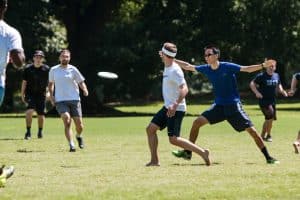Ultimate Frisbee 101
What is Ultimate Frisbee?
What exactly is Ultimate Frisbee? Ultimate Frisbee, also known simply as Ultimate, is a fast-paced, non-contact team sport played with a flying disc, commonly called a frisbee. The game combines football, basketball, and soccer elements, requiring athleticism, endurance, and strategic thinking. Ultimate emphasizes fair play, self-officiating, and the “Spirit of the Game,” fostering a unique blend of competition and sportsmanship.
The sport was created in 1968 by a group of high school students from Columbia High School in Maplewood, New Jersey, led by Joel Silver. They devised the game as a fun and competitive alternative to traditional sports. Ultimate quickly spread to other schools, and by the 1970s, it had gained popularity on college campuses across the United States.
The first intercollegiate tournament was held in 1975, and the Ultimate Players Association (UPA), now known as USA Ultimate, was founded in 1979 to govern the sport and promote its growth. It has since expanded globally, with organizations like the World Flying Disc Federation (WFDF) overseeing international competitions and the sport’s development worldwide.
Over the years, ultimate frisbee has experienced significant growth in recreational and competitive play. It is estimated that millions of people worldwide now play Ultimate, with leagues and clubs established in over 80 countries. The sport has become particularly popular in North America, Europe, and Australia, with an increasing presence in Asia, Africa, and South America.
Ultimate has gained recognition from several international sports organizations, including the International Olympic Committee (IOC) in 2015, which granted full recognition to the WFDF. This has opened the door for the potential inclusion of the sport in future Olympic Games.
The sport’s popularity can be attributed to its accessibility, affordability, and emphasis on sportsmanship. This game can be played in various settings, from local pick-up games to organized leagues and international competitions. Its unique combination of athletic challenge, strategic gameplay, and camaraderie has made it an attractive choice for players of all ages and skill levels.
Basic rules of ultimate frisbee and gameplay
1. The objective of the game
The primary objective of Ultimate Frisbee is to score points by throwing and passing the disc to a teammate in the opposing team’s end zone. Teams alternate possession of the disc, attempting to move it down the field by passing it to teammates while the opposing team tries to prevent them from scoring.
2. Playing field dimensions
An official Ultimate field is rectangular, with 120 yards (110 meters) in length and 40 yards (37 meters) in width. The field is divided into two end zones, each 20 yards (18 meters) deep, with a playing area of 80 yards (73 meters) between them.
3. Number of players and positions
Ultimate is typically played with seven players on each team, although variations exist for different formats and skill levels. There are no fixed positions in Ultimate, but players generally assume offensive and defensive roles. Offensively, players are usually divided into handlers (responsible for passing and distributing the disc) and cutters (who make quick moves to receive passes). Defensively, players can be assigned as markers (guarding the person with the disc) or as part of the downfield defense.
4. Starting the game: the pull
The game begins with a “pull,” similar to a kickoff in football. One team throws the disc to the opposing team, who takes possession and attempts to advance it down the field. After each point is scored, the teams switch the direction of play, and the scoring team initiates the next pull.
5. Scoring system
A point is scored when someone catches the disc in the opposing team’s end zone. The team that scored the most points at the end is the winner. Games are typically played to a predetermined number of points (e.g., 13 or 15) or until a time cap is reached.
6. Movement of the disc
Players can only move the disc by passing it to a teammate. The player holding the disc (the “thrower”) cannot run with it but is allowed to pivot on one foot. Once a pass is caught, the receiver must establish a pivot foot and has ten seconds to pass the disc to a teammate.
7. Turnovers and defense
A turnover occurs when a pass is intercepted, dropped, or thrown out of bounds or if the thrower fails to release the disc within the ten-second time limit. When a turnover occurs, the opposing team immediately takes possession of the disc, and they become the offense. Defensive strategies include marking (applying pressure on the thrower) and guarding receivers to prevent successful passes.
8. Fouls and penalties
Fouls occur when a player initiates contact with an opponent, interferes with their movement, or violates the rules of ultimate frisbee in a manner that affects the outcome of the play. Play usually stops when a foul is called, and the disc is returned to the thrower or advanced, depending on the specific foul. Players are expected to self-officiate, honestly calling fouls and resolving disputes.
9. Spirit of the Game
The “Spirit of the Game” is a fundamental aspect of ultimate frisbee, emphasizing sportsmanship, fair play, and self-officiating. It is the responsibility of each player to uphold the spirit of the game by playing with respect for their opponents, teammates, and the rules. This unique aspect of Ultimate fosters a strong sense of community and camaraderie among players, transcending the competitive nature of the sport.
Competitive play and ultimate frisbee tournaments
1. Local and regional leagues
Local and regional leagues allow players of all skill levels to participate in structured, competitive ultimate frisbee. These leagues often organize regular seasons, playoffs, and ultimate frisbee tournaments, fostering a sense of community and friendly competition among players. Local and regional leagues also serve as a platform for players to improve their skills, with many progressing to higher levels of competition.
2. National and international competitions
National and international competitions showcase the best teams and players worldwide. These events, organized by governing bodies such as USA Ultimate and the World Flying Disc Federation (WFDF), typically feature national, continental, and world championships. These competitions promote the sport, drive global growth, and celebrate excellence in the sport.
3. College and Club Ultimate
College and Club Ultimate represent two significant levels of competitive play in ultimate frisbee. College Ultimate, popular in the United States, features teams from universities and colleges competing against each other in regional and national championships. On the other hand, Club Ultimate consists of non-affiliated teams formed by players from various backgrounds. Both college and Club Ultimate offer competitive environments for players to develop their skills and form lasting friendships.
4. World Ultimate and Guts Championships
The World Ultimate and Guts Championships (WUGC) is a premier international event organized by the WFDF. Held every four years, the WUGC brings top national teams worldwide to compete in various divisions, including open, women’s, mixed, and masters. The event also features Guts Frisbee, another flying disc sport, which showcases teams competing in a fast-paced, disc-throwing competition.
5. Professional Ultimate leagues
In recent years, Ultimate professional leagues have emerged to provide opportunities for players to compete at the highest level. The most notable of these leagues is the American Ultimate Disc League (AUDL), which features teams across the United States and Canada. Professional leagues aim to elevate the sport’s profile, attract new fans, and provide a platform for the best players to showcase their skills. These leagues often feature unique rules and formats, such as referees and timed quarters, to enhance the spectator experience and create a more structured, professional environment.
Is the Ultimate Frisbee growing?
Expansion of professional leagues
As the popularity of Ultimate Frisbee continues to grow, the expansion of professional leagues is expected to play a significant role in the sport’s future. The success of the American Ultimate Disc League (AUDL) has demonstrated the potential for a sustainable professional league model, and other countries may follow suit. The development of more professional leagues will offer new opportunities for players to compete at the highest level and increase visibility and media coverage, attracting new fans and further elevating the sport’s profile.
Recognition by the International Olympic Committee
The International Olympic Committee’s (IOC) full recognition of the World Flying Disc Federation (WFDF) in 2015 has paved the way for the potential inclusion of the sport in future Olympic Games. As the sport continues to grow and meet the IOC’s criteria, it is possible that Ultimate could become an Olympic event, providing an even greater platform for global exposure and further legitimizing the sport in the eyes of the international sports community.
Growth in youth and school programs
The continued growth of youth and school programs will also shape the future of Ultimate Frisbee. These programs introduce the sport to younger generations, fostering a love for the sport and developing skills at an early age. Expanding youth and school programs will create a larger pool of talented players and contribute to the overall growth of the sport as more people become aware of and engaged in this extracurricular activity.
Development of new playing styles and strategies
As the sport evolves, so will the playing styles and strategies teams and players employ. Innovations in tactics, techniques, and training methods will continue to shape the game, pushing the limits of athleticism and strategic thinking. The increased popularity and competitiveness of the sport will also drive the development of new technologies and tools to assist in coaching, analytics, and performance tracking. This continuous evolution and adaptation will ensure that the activity remains a dynamic and exciting sport for players and spectators.
As you understand Ultimate Frisbee as a sport for your college life, if you are trying to learn how to enter college, AdmissionSight can give you the guidance you will need to enter college. You can get all the right information and guidance from experts at AdmissionSight. Start your journey today with an initial consultation.







































